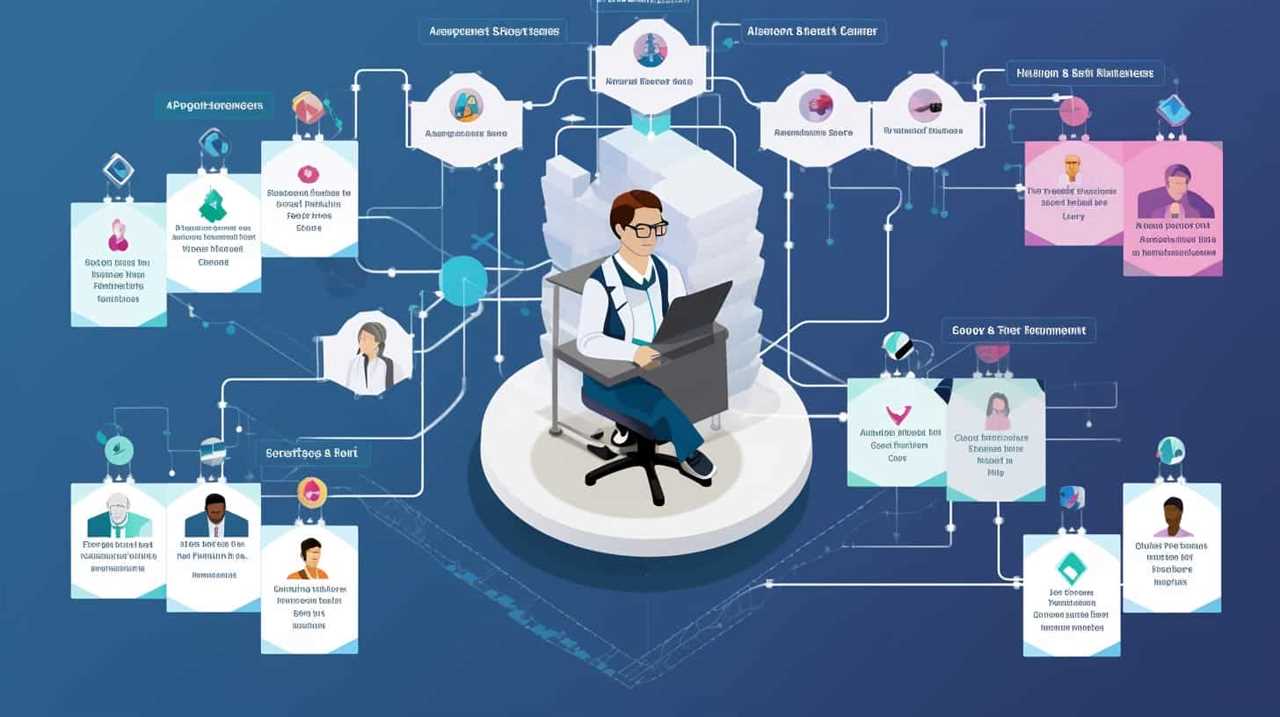Welcome to “Enhance Your Protection with Akamai Guardicore Solutions – A Detailed Guide.” In this guide, we explore how Akamai Guardicore Segmentation ensures the safety and freedom of your organization.
In today’s digital landscape, healthcare organizations require robust and trustworthy solutions to protect their critical assets and mitigate cyber threats.
This guide sheds light on the simplicity and efficiency of implementing Zero Trust principles, enabling you to reduce your attack surface and prevent lateral movement without the need for expensive security hardware.
By adopting a software-based microsegmentation approach, you can enhance network security and fortify your IT infrastructure against vulnerabilities.

Discover how Akamai Guardicore Solutions empowers you to maintain a true Zero Trust Strategy and navigate the ever-evolving realm of cybersecurity.
Key Takeaways
- Akamai Guardicore Solutions provides comprehensive and efficient security for healthcare organizations by leveraging microsegmentation technology.
- The solution offers advanced threat detection capabilities, including lateral movement detection and real-time threat detection using machine learning algorithms.
- Network segmentation enhances security by reducing the attack surface and providing granular control over network traffic.
- Akamai Guardicore Solutions simplifies security and compliance by providing a user-friendly interface, centralized visibility and control, and cost-effective security solutions.
Overview of Akamai Guardicore Solutions
Akamai Guardicore Solutions provides a comprehensive and efficient approach to security, offering healthcare organizations a trusted and reliable solution. With the increasing complexity of today’s cyber threats, healthcare organizations require advanced security measures to protect their sensitive data and critical IT assets.
Akamai Guardicore Solutions addresses these challenges by leveraging microsegmentation technology to create secure zones within the network, reducing the attack surface and preventing lateral movement of threats.
Microsegmentation is a software-based approach that allows organizations to divide their network into smaller segments, each with its own set of security policies and controls. This approach provides granular visibility and control over all devices within the network, ensuring that only authorized traffic is allowed to flow between segments.

By implementing microsegmentation, healthcare organizations can effectively enforce Zero Trust principles, ensuring that every device and user is authenticated and verified before accessing critical resources.
Furthermore, Akamai Guardicore Solutions excels in protecting hybrid cloud environments, which are highly complex and often pose significant security challenges. With the increasing adoption of cloud services in the healthcare industry, it is crucial to have a security solution that can seamlessly integrate with both on-premises and cloud-based infrastructure.
Akamai Guardicore Solutions provides this capability, allowing healthcare organizations to extend their security policies and controls to their hybrid cloud environments, ensuring consistent protection across their entire ecosystem.
Advanced Threat Detection Capabilities
Advanced threat detection capabilities are a crucial component of Akamai Guardicore Solutions, providing healthcare organizations with robust security measures to identify and mitigate potential cyber threats.

With the increasing frequency and sophistication of cyber attacks targeting healthcare systems, it is imperative for organizations to have advanced threat detection capabilities in place to safeguard sensitive patient data and critical infrastructure.
Guardicore offers a comprehensive suite of advanced threat detection features that enable healthcare organizations to stay one step ahead of attackers. Here are three key capabilities that set Guardicore apart:
- Lateral Movement Detection: Guardicore’s microsegmentation approach allows for the detection of lateral movement within the network. By monitoring network traffic and analyzing behavior patterns, Guardicore can identify suspicious activities and potential threats attempting to move laterally across the system. This proactive approach helps prevent the spread of malware and limits the attackers’ ability to navigate through the network.
- Real-time Threat Detection: Guardicore’s advanced threat detection capabilities provide real-time monitoring and analysis of network traffic, allowing for the immediate identification and mitigation of potential threats. By leveraging machine learning algorithms and behavioral analytics, Guardicore can detect anomalous activities indicative of a cyber attack. This enables healthcare organizations to respond swiftly and effectively, minimizing the impact of the threat.
- Granular Controls and Zero Trust Enforcement: Guardicore offers granular controls over the attack surface, allowing organizations to define and enforce access policies based on the principle of Zero Trust. This approach ensures that only authorized users and devices have access to critical resources, reducing the risk of data breaches and unauthorized access. With Guardicore, healthcare organizations can protect their critical IT assets from ransomware attacks and provide secure access to critical applications in hybrid cloud environments.
Network Segmentation for Enhanced Security
Network segmentation is a crucial aspect of enhancing security within healthcare organizations. This approach offers several benefits, including reducing the attack surface and preventing lateral movement of threats.
To implement segmentation effectively, organizations should follow best practices such as defining clear segmentation policies, regularly monitoring and updating access controls, and ensuring proper network design.

Additionally, it is important to consider the potential impact on network performance and optimize segmentation strategies accordingly.
Benefits of Segmentation
Segmentation plays a crucial role in enhancing security and protecting critical IT assets from data breaches and real-time threats. By implementing network segmentation, organizations can experience several benefits that contribute to a more secure environment. These benefits include:
- Reduced Attack Surface: Segmentation limits the lateral movement of threats within the network, preventing attackers from easily accessing critical assets. By dividing the network into smaller, isolated segments, the attack surface is minimized, making it more challenging for attackers to gain unauthorized access.
- Granular Controls: Network segmentation allows for granular control over network traffic, enabling organizations to implement specific security policies based on the needs of each segment. This level of control ensures that only authorized traffic is allowed, reducing the risk of unauthorized access and data breaches.
- Enhanced Incident Response: With segmentation, organizations can isolate compromised segments, preventing the spread of threats and minimizing the impact of potential incidents. This isolation allows for faster incident response and containment, reducing the time and effort required to mitigate security breaches.
Implementation Best Practices
To optimize security measures, it is imperative to consistently review and update network segmentation practices. Implementing network segmentation best practices can enhance security by reducing the attack surface and preventing lateral movement within the network.
Akamai Guardicore solutions offer a software-based microsegmentation approach that provides granular controls without the need for costly security hardware. This technology enforces Zero Trust principles, securing critical IT assets and reducing the risk of ransomware.

By implementing network segmentation, organizations gain full visibility of devices within the network, allowing them to detect and prevent lateral movement effectively. Guardicore solutions streamline security efforts by offering a single platform for detecting and preventing lateral movement, enhancing overall network security and reducing the risk of data breaches.
Consistently reviewing and updating network segmentation practices is crucial for maintaining a robust security posture.
Impact on Network Performance
Enhancing security through network segmentation has a significant impact on network performance. While the benefits of network segmentation are undeniable, it is important to understand the potential trade-offs in terms of network performance.
Here are three key factors that can affect network performance when implementing network segmentation with Akamai Guardicore solutions:

- Increased latency: Network segmentation can introduce additional routing and processing overhead, resulting in increased latency. This can impact the overall network performance, especially for latency-sensitive applications.
- Bandwidth constraints: Network segmentation can create smaller network segments with limited bandwidth capacity. As a result, network traffic may experience congestion and reduced throughput, affecting network performance.
- Administrative complexity: Implementing and managing network segmentation requires careful planning and configuration. This can increase administrative workload and complexity, potentially impacting network performance if not managed efficiently.
Despite these potential challenges, the benefits of enhanced security through network segmentation far outweigh the impact on network performance. By implementing proper access controls and policies, organizations can protect critical assets while ensuring optimal network performance.
Access Control to Protect Critical Assets
Implementing strong access control measures is crucial for protecting critical assets within your organization. With the increasing frequency and sophistication of cyber attacks, it is essential to have robust access control mechanisms in place to prevent unauthorized access and limit the potential damage caused by malicious actors.
Akamai Guardicore Solutions offers a comprehensive approach to access control through its microsegmentation technology. This software-based solution allows organizations to divide their network into smaller segments, creating virtual barriers that restrict the movement of unauthorized users. By implementing granular controls, organizations can ensure that only authorized individuals have access to critical assets, minimizing the risk of data breaches and unauthorized modifications.
Furthermore, Akamai Guardicore provides full visibility of all devices within the network, allowing organizations to monitor and manage access permissions effectively. This visibility reduces the risk of ransomware attacks by detecting and isolating compromised devices promptly.

The Role of Akamai Guardicore in Zero Trust Architecture
Akamai Guardicore plays a significant role in implementing Zero Trust architecture by providing a comprehensive solution that enhances the security of critical assets within an organization. Here are three key ways in which Akamai Guardicore contributes to the successful implementation of Zero Trust principles:
- Reducing the attack surface: Akamai Guardicore offers a software-based microsegmentation approach that enables organizations to divide their network into smaller, isolated segments. By doing so, it reduces the attack surface and limits lateral movement within the network, preventing unauthorized access to critical assets.
- Granular controls for real-time threat prevention: With Akamai Guardicore, organizations can implement granular controls that allow for real-time threat prevention across the cyberattack kill chain. This ensures that any suspicious activities or attempts to breach the Zero Trust architecture are detected and mitigated promptly.
- Enhancing network security in hybrid cloud environments: Akamai Guardicore seamlessly integrates with hybrid cloud ecosystems, providing consistent security policies across on-premises and cloud environments. This ensures that critical assets are protected, regardless of their location, and enables organizations to maintain a strong security posture in their evolving IT infrastructure.
By leveraging Akamai Guardicore’s solutions, organizations can establish a robust Zero Trust architecture that effectively safeguards their critical assets.
This sets the stage for the subsequent section, where we will explore how Akamai Guardicore can help in preventing ransomware attacks.
Preventing Ransomware Attacks With Akamai Guardicore
Ransomware attacks pose a significant threat to organizations, with the potential to cause significant financial and reputational damage.

Akamai Guardicore’s security solutions offer effective ransomware prevention measures by leveraging their microsegmentation technology.
This approach allows organizations to implement granular control over their network, reducing the attack surface and preventing lateral movement, ultimately mitigating the risk of ransomware infiltrating critical IT assets.
Effective Ransomware Prevention
With its granular controls and full visibility of network devices, Akamai Guardicore segmentation provides an effective solution for preventing ransomware attacks.
Its microsegmentation technology offers the following benefits:

- Lateral Movement Prevention: By segmenting the network into smaller, isolated zones, Guardicore stops the lateral movement of ransomware within the network. This prevents the spread of the malware and limits the damage it can cause.
- Enhanced Visibility: With full visibility of all devices within the network, Guardicore enables organizations to detect any suspicious behavior or anomalies that could indicate a ransomware attack. This proactive approach allows for rapid response and containment of the threat before it can cause significant harm.
- Zero Trust Enforcement: Guardicore enforces Zero Trust principles by implementing strict access controls and only allowing necessary connections between segments. This reduces the attack surface and prevents unauthorized access, making it harder for ransomware to infiltrate the network.
Guardicore’s Security Solutions
Guardicore’s comprehensive security solutions effectively prevent ransomware attacks by offering robust protection against lateral movement and unauthorized access. With their microsegmentation technology, Guardicore provides granular controls that stop the spread of ransomware within a network. By reducing the attack surface and enforcing Zero Trust principles, Guardicore solutions enhance overall network security against ransomware threats.
Healthcare organizations, in particular, benefit from Guardicore’s secure access to critical applications and protection of critical IT assets. By offering full visibility of all devices within the network and a single platform to prevent lateral movement, Guardicore solutions reduce the risk of data breaches.
Trusted by healthcare organizations, Guardicore’s microsegmentation technology not only protects systems from vulnerabilities but also streamlines security by providing the simplest and fastest route to implementing Zero Trust principles, ensuring freedom from ransomware attacks.
Safeguarding Remote Workforce With Akamai Guardicore
Akamai Guardicore’s solution provides comprehensive protection for remote workforce security. With the increasing trend of remote work, organizations need robust security measures to safeguard their employees and data. Here are three ways in which Akamai Guardicore helps in securing the remote workforce:

- Microsegmentation: Akamai Guardicore offers a software-based microsegmentation approach, which allows organizations to create isolated security zones within their network. This ensures that even if one segment is compromised, the rest of the network remains secure. By implementing granular control over network access, organizations can prevent lateral movement and limit the potential impact of any security breach.
- Zero Trust principles: Akamai Guardicore’s solution easily enforces Zero Trust principles, ensuring that every user and device is authenticated and authorized before accessing critical resources. This eliminates the traditional perimeter-based security model and provides a more robust and flexible security framework for remote workers.
- Endpoint protection: Akamai Guardicore extends its security capabilities to endpoints, protecting devices used by remote workers. By deploying advanced endpoint protection tools, organizations can detect and prevent malware infections, safeguard sensitive data, and mitigate the risk of data breaches.
With Akamai Guardicore’s comprehensive remote workforce security solutions in place, organizations can confidently embrace remote work while maintaining a strong security posture.
In the next section, we will explore how Akamai Guardicore enhances endpoint protection for a holistic security approach.
Endpoint Protection With Akamai Guardicore
Endpoint Protection with Akamai Guardicore offers complete security for endpoints by implementing robust security measures and enhanced threat detection capabilities.
With the solution’s comprehensive endpoint security features, organizations can effectively safeguard their critical IT assets from advanced threats and malicious activities.

Complete Endpoint Security
Complete endpoint security is essential for protecting healthcare organizations from cybersecurity threats. Akamai Guardicore offers a comprehensive solution for endpoint protection, ensuring the safety and integrity of critical IT assets within healthcare environments.
Here are three key aspects of Akamai Guardicore’s endpoint security:
- Microsegmentation: Akamai Guardicore’s software-based microsegmentation technology reduces the attack surface by creating granular controls and preventing lateral movement. This approach effectively isolates and protects individual endpoints from potential threats.
- Zero Trust Principles: With Akamai Guardicore, healthcare organizations can enforce Zero Trust principles across their hybrid cloud ecosystems. This means that every request, regardless of its source, is verified and authenticated before access is granted, reducing the risk of unauthorized access and potential breaches.
- Real-time Threat Protection: Akamai Guardicore provides full visibility of all devices within the network, allowing for real-time threat detection and prevention. By continuously monitoring the system, it can identify and respond to potential threats promptly, minimizing the risk of ransomware attacks and other cybersecurity incidents.
Enhanced Threat Detection
Enhanced threat detection is a crucial aspect of endpoint protection, ensuring optimal security for healthcare organizations utilizing Akamai Guardicore solutions.
With its microsegmentation technology, Guardicore provides granular controls to stop lateral movement and protect systems from vulnerabilities.

By reducing the attack surface without costly security hardware, Guardicore’s software-based microsegmentation approach detects lateral movement and real-time threats. This allows for the implementation of granular controls that prevent lateral movement and reduce the risk of data breaches.
The solution easily enforces Zero Trust principles and offers secure access to critical applications, protecting them from ransomware attacks.
Accelerating Compliance and Replacing Internal Firewalls
To accelerate compliance and enhance security, Akamai Guardicore solutions offer a streamlined approach for replacing internal firewalls. By leveraging their software-based microsegmentation technology, organizations can achieve the following:
- Simplified Compliance: Akamai Guardicore solutions provide granular control over the attack surface, enabling organizations to easily enforce compliance regulations. With detailed visibility and control over network traffic, organizations can effectively monitor and manage access to sensitive data, ensuring compliance with industry standards and regulations such as HIPAA and GDPR.
- Enhanced Security: Traditional internal firewalls may not provide sufficient protection against advanced threats and lateral movement. Akamai Guardicore’s microsegmentation approach reduces the attack surface and prevents lateral movement in real-time, effectively mitigating the risk of ransomware and other cyber threats. By replacing internal firewalls with Akamai Guardicore solutions, organizations can strengthen their security posture and protect critical IT assets.
- Cost Savings: Replacing hardware-based internal firewalls with software-based microsegmentation eliminates the need for costly security infrastructure. Akamai Guardicore solutions offer a more cost-effective alternative, allowing organizations to optimize their security investments while maintaining a high level of protection.
Ring-Fencing Critical Applications With Akamai Guardicore
Akamai Guardicore offers a solution for ring-fencing critical applications to enhance security and protect against cyber threats. By implementing Akamai Guardicore’s software-based microsegmentation approach, organizations can reduce the attack surface and prevent lateral movement of threats within their network. This approach provides granular controls that protect critical IT assets from vulnerabilities and real-time threats across the entire cyberattack kill chain.

To convey a deeper understanding of how Akamai Guardicore’s ring-fencing solution works, the following table provides a breakdown of its key features:
| Key Features | Description | Benefits |
|---|---|---|
| Software-based Microsegmentation | Reduces attack surface without costly security hardware | Enhances security, reduces risk |
| Granular Controls | Protects critical IT assets from vulnerabilities and threats | Prevents lateral movement, enhances overall security |
| Full Visibility | Provides visibility of all devices within the network | Reduces risk of ransomware, enhances security |
| Zero Trust Enforcement | Enforces Zero Trust principles, protects critical IT assets | Offers secure access to critical applications |
| Comprehensive Security Measures | Maintains a true Zero-Trust Strategy | Enhances network security, reduces risk of data breaches |
With Akamai Guardicore’s ring-fencing solution, organizations can ensure the security of their critical applications by implementing granular controls, enforcing Zero Trust principles, and maintaining a comprehensive security strategy. This helps protect against cyber threats and reduces the risk of data breaches, providing organizations with the freedom to operate securely in today’s threat-filled cyber landscape.
Securing Legacy Systems With Akamai Guardicore
Implementing Akamai Guardicore’s software-based microsegmentation approach allows organizations to secure their legacy systems by reducing the attack surface and preventing lateral movement of threats within the network.
With the increasing number of cyber threats targeting legacy systems, it is crucial for organizations to adopt comprehensive security measures that protect these critical assets. Akamai Guardicore’s solutions provide the necessary capabilities to secure legacy systems effectively.

Here are three key ways in which Akamai Guardicore helps secure legacy systems:
- Reducing the attack surface: Akamai Guardicore’s microsegmentation approach enables organizations to create granular security policies that separate legacy systems from the rest of the network. By segmenting the network into smaller, isolated zones, the attack surface is minimized, limiting the potential entry points for attackers.
- Preventing lateral movement of threats: With Akamai Guardicore, organizations can implement strict access controls and enforce Zero Trust principles within their legacy systems. This prevents threats from spreading laterally within the network, limiting the impact of potential breaches and minimizing the risk of data loss.
- Enhancing visibility and control: Akamai Guardicore provides organizations with comprehensive visibility into network traffic, allowing them to detect and respond to potential threats quickly. By gaining real-time insights into the behavior of their legacy systems, organizations can proactively identify and mitigate security risks.
Real-World Case Studies of Akamai Guardicore Implementation
In a guide titled ‘Streamline Your Security With Akamai Guardicore Solutions’, the discussion now moves towards the real-world case studies of implementing this advanced security solution.
Akamai Guardicore segmentation has been successfully implemented by various healthcare organizations, proving its effectiveness in protecting critical IT assets within hybrid cloud ecosystems.
One such case study involves a large hospital network that was struggling to secure their legacy systems and prevent lateral movement of threats. By implementing Akamai Guardicore microsegmentation technology, they were able to achieve granular controls and reduce the attack surface without the need for costly security hardware. This solution effectively enforced Zero Trust principles and significantly reduced the risk of ransomware attacks.

Another case study involves a healthcare insurance provider that was facing challenges in securing their network and preventing unauthorized access to sensitive patient data. With Akamai Guardicore, they were able to implement a robust security framework that provided real-time threat prevention and enhanced visibility into their network traffic.
These real-world case studies highlight the successful implementation of Akamai Guardicore solutions in diverse healthcare environments, showcasing its ability to streamline security and protect critical assets.
Now, let’s delve into the customer viewpoints on Akamai Guardicore solutions.
Customer Viewpoints on Akamai Guardicore Solutions
The customers of Akamai Guardicore solutions have expressed their satisfaction with the streamlined security and enhanced protection provided by the software-based microsegmentation technology. Here are three key viewpoints from customers:

- Simplified Security Management: Customers appreciate the simplicity of managing their security infrastructure with Akamai Guardicore solutions. The intuitive interface and easy-to-use controls allow them to quickly implement and enforce security policies across their network. This simplification has resulted in significant time and cost savings for organizations, as they no longer need to invest in complex and expensive security hardware.
- Effective Lateral Movement Prevention: Akamai Guardicore’s microsegmentation technology has proven to be highly effective in stopping lateral movement within networks. Customers have reported a significant reduction in the risk of unauthorized access and the spread of malware. The granular controls provided by the solution allow organizations to limit access to sensitive systems and resources, ensuring that only authorized users can interact with them.
- Enhanced Zero Trust Implementation: Implementing a Zero Trust security model is a top priority for many organizations, and Akamai Guardicore solutions have been instrumental in achieving this goal. Customers have praised the software’s ability to enforce Zero Trust principles by providing real-time threat detection and response capabilities. With Akamai Guardicore, organizations can better protect their critical IT assets from ransomware attacks and other advanced threats, ultimately enhancing the overall security posture of their hybrid cloud ecosystems.
Frequently Asked Questions
What Is the Guardicore?
Guardicore is a trusted security solution that offers a software-based microsegmentation approach to reduce the attack surface without the need for expensive security hardware.
It provides granular controls to prevent lateral movement and real-time threats, protecting critical IT assets and enforcing Zero Trust principles.
Guardicore’s microsegmentation technology helps protect systems from vulnerabilities, reducing the risk of ransomware and improving overall security.
With full visibility of all devices within the network and a commitment to Zero Trust principles, Guardicore helps maintain a true Zero-Trust Strategy in today’s threat-filled cyber landscape.

What Is the Difference Between Algosec and Guardicore?
The difference between Algosec and Guardicore lies in their approach to security.
Guardicore offers a software-based microsegmentation approach, providing granular control over the attack surface and a comprehensive solution for preventing lateral movement and real-time threats.
On the other hand, Algosec may require costly security hardware and may not offer the same level of granularity or protection for critical assets.
Guardicore also enhances security in hybrid cloud ecosystems, while Algosec may not provide the same level of security for such environments.

What Is the Guardicore Centra Security Platform?
The Guardicore Centra Security Platform is a trusted solution used by healthcare organizations to streamline security.
It offers a simple and intuitive approach to implementing Zero Trust principles, effectively stopping lateral movement and protecting against vulnerabilities.
With its microsegmentation technology, the platform provides granular controls and full visibility of all devices within the network, reducing the risk of ransomware.
Additionally, it eliminates the need for costly security hardware through its software-based approach, thereby reducing the attack surface.

Who Owns Akamai?
Akamai is a publicly traded company with ownership distributed among institutional investors, mutual funds, and individual shareholders. As a publicly traded company, Akamai’s ownership structure is transparent and subject to regulatory filings and disclosures. The company’s stock is traded on the NASDAQ stock exchange under the symbol ‘AKAM’.
Akamai’s diverse ownership base reflects the confidence that investors have in the company’s business and growth prospects.
Conclusion
In conclusion, Akamai Guardicore Solutions offers healthcare organizations a valuable and trustworthy security solution.
With its software-based microsegmentation approach, organizations can streamline their security measures without the need for expensive hardware.

By implementing Zero Trust principles and preventing lateral movement, critical IT assets are protected, enhancing overall network security.
Akamai Guardicore’s advanced threat detection capabilities, network segmentation, and access control contribute to a true Zero Trust Strategy.
Overall, Akamai Guardicore provides a robust and effective solution for healthcare organizations’ security needs.









